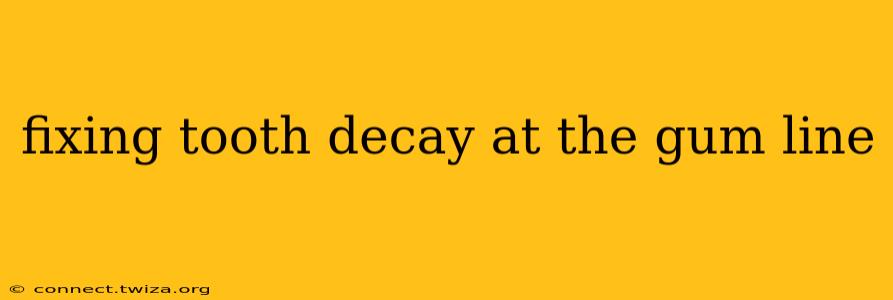Tooth decay at the gum line, also known as gingival decay, is a particularly challenging type of cavity. Its location makes it harder to detect and treat effectively, often requiring more advanced dental procedures. This comprehensive guide explores the causes, detection, treatment, and prevention of gum line decay.
What Causes Tooth Decay at the Gum Line?
Gingival decay arises from a combination of factors, many of which stem from poor oral hygiene and lifestyle choices.
- Poor Oral Hygiene: Insufficient brushing and flossing allow plaque and bacteria to accumulate along the gum line, where they produce acids that erode tooth enamel. This area is particularly vulnerable because it's often missed during brushing.
- Receding Gums: As gums recede, more of the tooth root is exposed, making it more susceptible to decay. Receding gums can be caused by gum disease (periodontitis), aggressive brushing, or genetics.
- Sugar Consumption: Frequent consumption of sugary foods and drinks fuels bacterial growth, accelerating the decay process.
- Dry Mouth: Saliva plays a crucial role in neutralizing acids and protecting teeth. Dry mouth, caused by certain medications or medical conditions, increases the risk of decay.
- Dental Restorations: Decay can occur around existing fillings, crowns, or other dental restorations, particularly if they're old or improperly placed.
How is Gum Line Decay Detected?
Detecting gum line decay can be tricky due to its hidden location. Your dentist will employ several methods:
- Visual Examination: A thorough visual examination using specialized instruments and lighting will help identify any discoloration or irregularities along the gum line.
- X-rays: Dental X-rays provide a detailed view of the tooth structure, revealing decay that might not be visible to the naked eye.
- Probing: The dentist uses a small probe to gently explore the gum line and assess the depth and extent of any decay.
What are the Treatment Options for Gum Line Decay?
Treatment depends on the severity of the decay:
- Minor Decay: In the early stages, your dentist might recommend fluoride treatments or dental sealants to strengthen the enamel and prevent further decay.
- Moderate Decay: If the decay has progressed further, a filling might be necessary. However, the proximity to the gum line can make this procedure more challenging, potentially requiring special techniques and materials.
- Severe Decay: In advanced cases, a crown or other more extensive restorative work may be required. In rare instances, extraction might be necessary if the tooth is severely damaged.
Can Gum Line Decay Be Prevented?
Prevention is key. Adopting these habits can significantly reduce your risk:
- Maintain Excellent Oral Hygiene: Brush your teeth twice daily with fluoride toothpaste, and floss at least once a day. Pay particular attention to the gum line.
- Reduce Sugar Intake: Limit your consumption of sugary foods and drinks.
- Regular Dental Checkups: Schedule regular checkups and cleanings with your dentist for early detection and prevention.
- Address Gum Disease: If you have gum disease, seek professional treatment promptly to prevent gum recession.
- Consider Fluoride Treatments: Fluoride treatments can help strengthen tooth enamel and make it more resistant to decay.
How Do I Know If I Have Gum Recession?
Gum recession is often noticeable as a lengthening of the teeth, exposing more of the tooth root. You might also experience sensitivity to hot or cold temperatures, or notice bleeding or redness along the gum line. Regular dental checkups are crucial for early detection.
What Happens If Gum Line Decay Is Left Untreated?
Untreated gum line decay can lead to severe complications, including:
- Abscesses: Infected pockets of pus can form around the tooth.
- Periodontal Disease: The infection can spread to the surrounding gum tissues, leading to gum disease.
- Tooth Loss: In advanced cases, the tooth may become so damaged that extraction is necessary.
Are There Special Considerations for Treating Gum Line Decay?
Yes, treating gum line decay often requires more precision and expertise due to its location. The dentist needs to carefully manage the restoration process to avoid further gum recession or irritation.
By understanding the causes, prevention strategies, and treatment options for gum line decay, you can take proactive steps to protect your oral health and maintain a bright, healthy smile. Remember that regular dental checkups are crucial for early detection and prevention.
